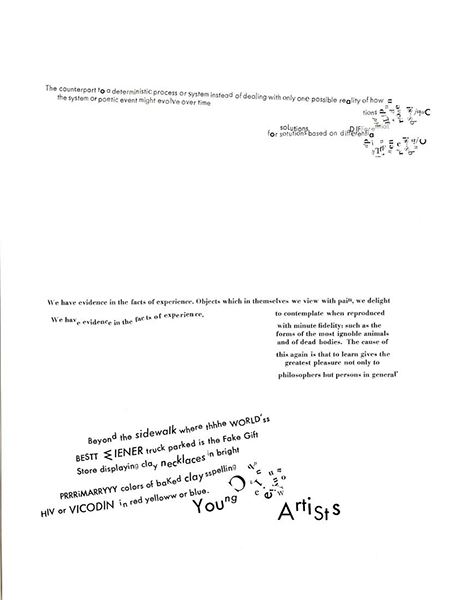Unlike many of the authors who have blogged here before, my primary work is in English literature—well, according to the language on my degree, at least. More specifically, I work at the intersection of theory or philosophy and artists’ books. Along these lines, my dissertation considered a small but critically significant section of arguments that enact their arguments through their material form: the Encyclopedia Da Costa of Georges Bataille, Marcel Duchamp, and others; Jacques Derrida’s two-columned Glas; Avital Ronell’s The Telephone Book, which meanders in and out of legibility; Mark C. Taylor’s wildly colorful and typographically innovative Hiding and its accompanying forward-thinking 1998 digital literature work The Réal: Las Vegas, NV; and Johanna Drucker’s Stochastic Poetics and Susan Howe’s Tom Tit Tot, two artists’ books commonly recognized as such that nevertheless extend the threads set out by material arguments. Taken together, these works blur notions of how the argument genre operates.
Perhaps it is no surprise, then, that often a description of my work is met with a furrowed brow from other English scholars. But how is it English? Well, it is, and it isn’t: true, it moves against a conventional sense of English as a field of set and stable genres; nevertheless, it emphasizes careful consideration of the stakes of a text and reflects back onto how we read. Insisting on fluidity, this kind of work argues for the necessary incorporation of other elements, gathered from critical theory, from media studies and communication theory, from what Jonathan Rose, in a speech for the Society for the History of Authorship, Reading and Publishing, calls “book studies.” What I term in the dissertation material arguments, or theoretical artists’ books, are critical of the usual jobs of criticism, relentlessly seeking to provoke the reader rather than engage them in counterargument or as adversary. (“You can’t wrestle with a man who won’t wrestle back,” as Jack Miles characterizes Taylor in the introduction.)
Moreover, the readerly provocations of theoretical artists’ books are located firmly in the material forms of the work, expressed through typography and design and media: for example, the blurred letterforms that visually replicate deafness in The Telephone Book; the juxtaposition of text and image in the Encyclopedia Da Costa that conveys absurdity and comedy; or the translucent paper that allows photos in Hiding to “bleed” through the text on the other side of the page during a discussion of skin. It becomes impossible to separate form from content, material from argument—theoretical artists’ books are irreducible to a bottom-line argument, requiring a multisensory, haptic experience.
Theoretical artists’ books is a strong term, and subject to pushback of its own. But it is always worth reconsidering the assumed delineations of the artists’ books genre, which readily accepts fiction, poetry, and essay. Why not argument? In 1981, in the New York Times, Geoffrey Hartmann makes a case for expanding the scope of argumentative texts to include a “literature of criticism.” Theory or criticism, Hartmann argues, has as much a claim to hybridization of genres as literature does: “[I]f there is no reason to deny the critical essay a dignity and even a creative touch of its own, then criticism, too, will have to be read closely. It should not be fobbed off as a secondary activity, as a handmaiden to more ‘creative’ modes of thinking like poems or novels.” Theoretical artists’ books reference their own bookishness; their material provocations are essential, not ornamental; they interrupt and recreate reading.
Questioning the boundaries of genre, we begin to also note that any field is always already subject to rifts and fractures and outgrowths. Artists’ books are hardly an exception, and these shifting contexts are beneficial: they allow for multiple perspectives. Stochastic Poetics will be familiar to many readers of this blog, but what about the work of poet Susan Howe? Like Stochastic Poetics, Howe’s Tom Tit Tot is highly citational, poses challenges to reading, and incorporates self-reflexivity about its production into its (handmade, letterpress-printed) presentation. Nor is it an anomaly in Howe’s oeuvre, which famously incorporates marginalia and collage, emphasizing the materiality of text. (In interviews, Howe has acknowledged her origins as a creator of what she considers visual art, textworks, before turning to poetry.) 
Johanna Drucker, Stochastic Poetics

Susan Howe. Tom Tit Tot
At the University of Buffalo, both Stochastic and Tom can be accessed in the rare books room. But they come from different areas, I am told: Stochastic is classified as an art object, and Tom is an artist’s book. Pressing for further information, I am met with a shrug and an acknowledgement. It’s likely, the librarian notes, they will be reclassified soon.
Works Cited
Hartmann, Geoffrey. “How Creative Should Literary Criticism Be?” New York Times, 5 April 1981, www.nytimes.com/1981/04/05/books/how-creative-should-literary-criticism-be.html. Accessed 3 April 2017.
Miles, Jack. “How To Read This Book: A Note to the Reader from a Concerned Friend.” Introduction to Hiding, by Mark C. Taylor, U of Chicago P, 1997.
Rose, Jonathan. “From Book History to Book Studies.” American Printing History Association, printinghistory.org/awards/page/8. Accessed 3 April 2017.

